Selecting anchor clips for metal cladding
by maz_atta | July 30, 2021 12:00 pm
Stephen Scharr
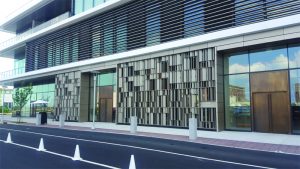 [1]
[1]Architects seeking to deliver their own, creative signature realize they must focus much of their attention on the design of the exterior wall, the face of the structure to the outside world. It delivers the first impression, defines the building’s personality, and telegraphs its function.
Today’s design trends drive those same architects to source a wide array of applied architectural features that are mounted to the building structure. This includes cantilevered elements that are fully exposed to the elements.
Exterior mounted perforated metal screen walls, grille assemblies, solar shading, applied architectural fins, and other unitized architectural metal assemblies require secure, dynamic, and adjustable structural anchors that are a durable solution for long-term service. Unlike curtain wall assemblies, windows and exterior wall cladding systems, the anchors that are used to attach these features to the building are fully exposed to rain, snow, temperature changes, salt spray, and other environmental elements. Each one of these external forces can accelerate corrosion and adversely affect the structural properties of these components over time. A failing anchor is laden with potential liability for risks to property and personal injury.
Given this, screen walls and unitized architectural assemblies require careful design and material selection (to avoid corrosion risk), so they perform adequately to resist design loads, and to permit the management of varying tolerances in terms of structural and architectural alignment.
For many designs, the anchor clip is also exposed to view and must be an attractive part of the product appearance. If the design is based on a variety of coated aluminum colors, the anchor clips must correlate with that design approach in terms of color and curb appeal.
Proper material selection
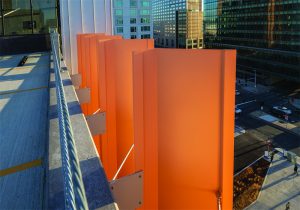 [2]
[2]From the beginning, it is important to select materials that are compatible with the substrate, environmental conditions, and each other.
In most cases, architectural metal assemblies are comprised of a series of coated aluminum features. Using coated architectural aluminum enables the architect to conduct free expression on the façade, including a vibrant selection of colors and shapes. Usually, a coated aluminum or stainless-steel hardware and anchor clips are preferred to avoid the risk of electrolytic corrosion that can occur between dissimilar metals in the presence of a corrosive solution.
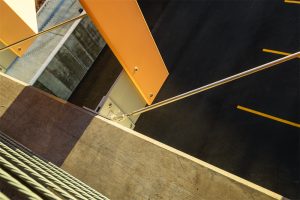 [3]
[3]A grille or screen wall assembly includes a myriad of components, and each component should be coated separately prior to assembly to ensure all surfaces are coated. It is critical that all end cuts, milled edges, and clear mounting holes have protection from the elements.
Components that are fabricated from stock-pre-coated sections will have exposed, uncoated edges or metal-to-metal contact surfaces that could be unprotected. These conditions will violate any coating warranty, increase vulnerability to edge creep at the coating/material interface, and could result in a coating failure. The same is true of the anchor clip attachment to the assembly. It is essential these critical components receive the necessary coating after they are fabricated.
Stainless steel possesses structural properties that are much greater than that of aluminum. Bearing this in mind, lighter materials can be considered when the profile or geometry of the design is more important than the colors. Some designers prefer the metallic appearance of these façade assemblies. Risk of corrosion for a stainless-steel element is reduced by the composition of this material. In these cases, a stainless-steel anchor clip is the logical solution for attachment. If it is a coastal installation, T316 stainless steel alloy is preferred over a common T304 alloy.
Structural substrate considerations
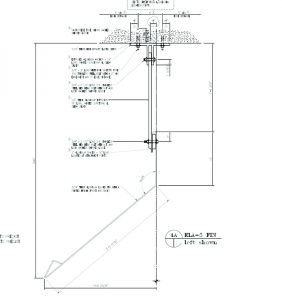
The next important question to ask: Is the attachment to cast-in-place concrete, precast concrete, steel, aluminum, or a composite structure?
Often, architectural metal assemblies are designed to span from slab to slab of a building structure. In many cases, the structure is precast or cast-in-place concrete. Whether the attachment clip is mounted to the structure using a drilled expansion anchor or an embedded steel insert channel the same basic principles will apply.
As noted previously, protecting the aluminum anchor clips on all surfaces is critical. This is particularly important when the risk of exposure to salt spray or concrete runoff is present. When an anchor clip is attached to or adjacent to a concrete substrate, it is essential the coating is applied after the part is fabricated so all edges and clear holes are completely coated. Coatings can be spray-applied polyvinylidene fluoride (PVDF), dry thermally cured powder coatings, or a wash coating such as anodizing. If the clip is exposed to view and a part of the design, then a PVDF color may be selected.
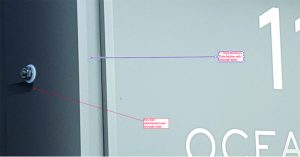 [4]
[4]Salt- or concrete-laden moisture intrusion is destructive to an aluminum substrate, especially if the moisture is not permitted to dry in between weather events. Anchors situated on vertical surfaces are more likely to be ‘washed’ during a weather event and are able to dry out. Anchors on skyward-facing surfaces are more vulnerable to exposure to a solution of runoff and should be avoided. If these situations are impossible to avoid, then a stainless-steel anchor clip is a much better alternative (see Figures 1, 2 [page 19], and 3, for examples of full coating protection).
Protection steps are critical at each layer of the anchor assembly.
Connection surfaces
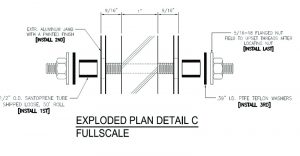 [5]
[5]Where the actual assembly is bolted to the anchor clips, nonmetallic bushings and bearing sleeves should be used to isolate stainless steel hardware from penetrating the coated aluminum surfaces and exposing an unprotected aluminum substrate (see Figures 4 and 5 for illustrations of hardware protections).
Bearing surfaces
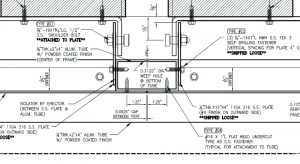 [6]
[6]It is important to isolate the clip from the structural substrate. An aluminum anchor clip must be carefully coated and isolated from the concrete or steel structural substrate with a nonmetallic isolation material of sufficient thickness and strength to resist the compression of the loads imposed and interrupt the conductivity of an electrolytic current. Ultraviolet (UV) and weather-resistant high-density plastic shims or spacers are commonly used here.
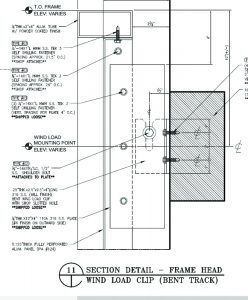 [7]
[7]In Figures 1, 2 , and 3, there is a double-tee extruded anchor clip with a nonmetallic spacer pad (shim) to isolate the coated aluminum from the concrete structure. There is a standoff plate inserted into the double-stemmed tee to create the desired cantilever off the face of the structure. The holes between the anchor clip and the standoff plate are isolated from the stainless steel through bolts using polytetrafluoroethylene (PTFE) washers and sleeves to prevent the stainless steel from damaging the finished aluminum. The same isolation is needed between the coated aluminum fin feature and the stainless-steel hardware that attaches the fin to the standoff plates. Even though these surfaces are coated, the movement of the parts during installation or in service under thermal and wind loads could cause the threads in the fasteners to gouge the aluminum and make the substrate vulnerable to corrosion.
Managing tolerance, load connections
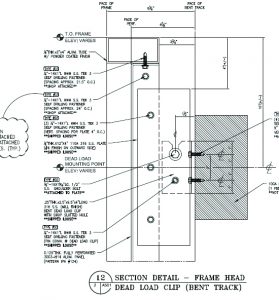 [8]
[8]Good design and specifications should always consider the accumulated tolerances present in any building project. Each element of a construction product must be analyzed based on several factors: material tolerance, fabrication tolerance, and installation tolerance. The larger the element, the greater these tolerances can be. This is particularly true when an architectural assembly is mounted directly to a structural assembly, because there are usually no secondary supports to create a layer to transition from structural to architectural tolerances. The dimensional tolerances expected from a structural element (usually +/- 25 to 50 mm [1 to 2 in.] per 6 m [20 ft]) are far greater than those of an architectural element (usually +/- 6 mm [0.25 in.] in 6 m). For this reason, the best practice is to provide an allowance in the anchor clip design to permit field adjustment for plumb (in and out) and vertical elevation within the anchor clips. This can be accomplished easily using a two-piece anchor clip design with slotted holes or a serrated pre-engineered adjustable clip arrangement available from a variety of sources. Some shimming is acceptable for in-and-out plumb tolerance management. However, excessive shimming creates structural problems with the capacity of the anchor hardware.
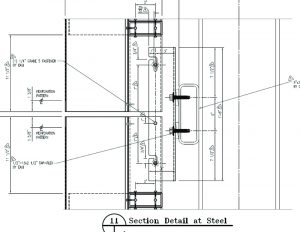 [9]
[9]In addition to tolerance management, the anchor clip must be designed to incorporate live and dead load connections. Live load connections may be slotted or sleeved connections, which will allow movement for thermal and live loads deflections of slab edges or other structural attachment points (see Figures 9 and 10) for simple examples of dead and live load anchor clips). The dead load anchor bolt is bearing on the open slot, which is carrying the entire dead load of the assembly. The wind load anchor is not bearing the weight of the assembly, but the open slot allows the assembly to expand and contract vertically to accommodate thermal movements and live load deflections on a floor slab while still resisting positive and negative wind load deflection horizontally.
The systemic approach
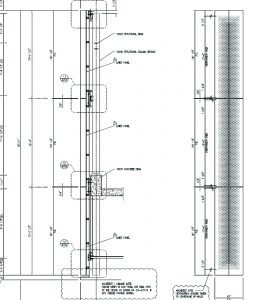 [10]
[10]Formed architectural metal assemblies can be produced in a wide array of geometric styles, surfaces, materials, and finishes. The anchor clips required for these assemblies must also be suitable to accommodate a variety of service conditions, structural substrates, and material finishes for strong and durable serviceability.
The best practice is to specify an assembly manufacturer that will include the entire design and production of the assemblies from the structure out.
In this way, the specifier can be assured materials are compatible, that finishes coordinate with each other, and the anchor designs can accommodate all conditions expected on the project.
- [Image]: https://www.constructionspecifier.com/wp-content/uploads/2021/08/Figure-6-Opener_Cladding.jpg
- [Image]: https://www.constructionspecifier.com/wp-content/uploads/2021/08/Figure-1_Cladding.jpg
- [Image]: https://www.constructionspecifier.com/wp-content/uploads/2021/08/Figure-2_Cladding.jpg
- [Image]: https://www.constructionspecifier.com/wp-content/uploads/2021/08/Figure4_Cladding.jpg
- [Image]: https://www.constructionspecifier.com/wp-content/uploads/2021/08/Figure5_Cladding.jpg
- [Image]: https://www.constructionspecifier.com/wp-content/uploads/2021/08/Figure6_Cladding.jpg
- [Image]: https://www.constructionspecifier.com/wp-content/uploads/2021/08/Figure7_Cladding.jpg
- [Image]: https://www.constructionspecifier.com/wp-content/uploads/2021/08/Figure8_Cladding.jpg
- [Image]: https://www.constructionspecifier.com/wp-content/uploads/2021/08/Figure9_Cladding.jpg
- [Image]: https://www.constructionspecifier.com/wp-content/uploads/2021/08/Figure10_Cladding.jpg
- stevescharr@metalwerksusa.com: mailto:stevescharr@metalwerksusa.com
Source URL: https://www.constructionspecifier.com/selecting-anchor-clips-for-metal-cladding/
 Stephen Scharr is co-owner and head of business development for Metalwërks. Founded in 1968, Metalwërks is a manufacturer of precision, high-performance metal plate exterior façade systems, integrated curtain wall components, and custom architectural features. Scharr can be reached via email at stevescharr@metalwerksusa.com[11].
Stephen Scharr is co-owner and head of business development for Metalwërks. Founded in 1968, Metalwërks is a manufacturer of precision, high-performance metal plate exterior façade systems, integrated curtain wall components, and custom architectural features. Scharr can be reached via email at stevescharr@metalwerksusa.com[11].